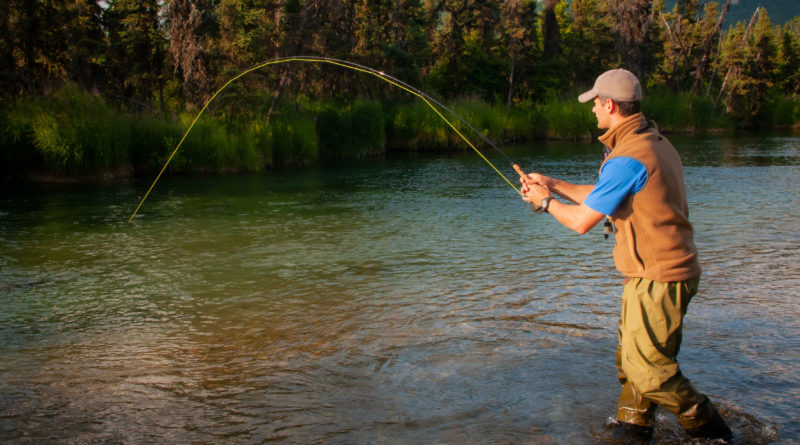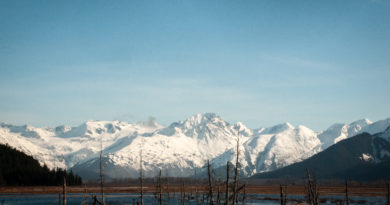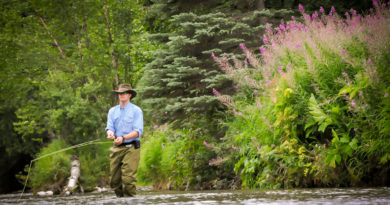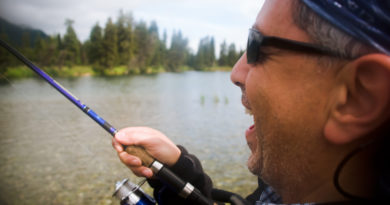Freshwater Fish in Alaska – The Top 5
Most serious anglers dream about fishing in Alaska. It is quite an experience! The big saltwater trophies are great, but I also love fishing for freshwater fish in Alaska. There are several ways you can experience Alaska fishing (read about them here). No matter how you choose, it can be the adventure of a lifetime. There are dozens of species of fish to go after. Each of these species requires a specific plan. You must choose the proper location and season of the year if you want to catch a particular fish. Below you will find the top five freshwater fish to catch in Alaska. (For a list of my favorite saltwater fish click here)
Freshwater Fish in Alaska
Cutthroat Trout
Description of Cutthroat Trout
The Cutthroat Trout is a common fish living from Southeast Alaska as far as Prince William Sound. It is the most common trout species in the region. Cutthroat trout come in both androgenous (sea-run) and freshwater-resident varieties. The sea-run varieties generally live in rivers and streams with accessible lakes. The freshwater-resident version lives in a variety of habitats including lakes, ponds, and rivers. No one really knows why there are both varieties and to what extent they interbreed.
It is the most common trout species in the region. Cutthroat trout come in both androgenous (sea-run) and freshwater-resident varieties. The sea-run varieties generally live in rivers and streams with accessible lakes. The freshwater-resident version lives in a variety of habitats including lakes, ponds, and rivers. No one really knows why there are both varieties and to what extent they interbreed.
Bright red slashes on the cheek give these sport fish their name as it looks like their throats have been sliced. Freshwater-resident Cutthroat range from 6-24 inches long. The sea-run variety is generally smaller rarely reaching 18 inches. Sea-run cutthroat tend to be less colorful with slash marks that are less prominent. As they progress to their spawning ground, they often become more closely colored to the freshwater version.
The sea-run version of cutthroat trout spend the first 3-4 years of their life in freshwater before they make their first migration to the sea. They can migrate up to 3 times, however, only 40% survive their first migration and only 1% survive to their third migration! When migrating to the sea, they spend between a few days up to 100 days in the ocean. The cutthroat has a very accurate sense of direction as they almost always return to the very stream where they were spawned to have their own offspring!
How to Fish for Cutthroat Trout
 Cutthroat Trout are found in lakes, ponds, streams and rivers along the coast of the Southeast portion of Alaska as far west as Prince William Sound around the town of Whittier. The best way to fish for cutthroat trout is with a fly rod. It is a highly sought after fish for the avid fly fisherman.
Cutthroat Trout are found in lakes, ponds, streams and rivers along the coast of the Southeast portion of Alaska as far west as Prince William Sound around the town of Whittier. The best way to fish for cutthroat trout is with a fly rod. It is a highly sought after fish for the avid fly fisherman.
Cutthroat tend to prefer an ambush attack on the dry fly, so it is wise to look for cover on the river or lake in order to entice the sea-run cutthroat. Flies resembling stoneflies, caddis flies and mayflies are a good place to start when fishing for cutthroat. Spinnerbait and other trout lures can be used for lake fishing for freshwater-resident cutthroat.
Due to a high mortality rate of cutthroat caught on live bait, it is prohibited in a large portion of the cutthroat range in Alaska. There is currently no particular season for cutthroat fishing.
Rainbow and Steelhead Trout
Description of Rainbow and Steelhead Trout
One of the most beautiful trout species is the Rainbow Trout. The rainbow is also known as the Steelhead trout. The hefty fighting skills of the rainbow make it a highly sought after fish for sport fisherman around the world. There are two forms of rainbow trout in Alaska. The form generally referred to as rainbow live their entire lives as residents of freshwater lakes and  streams. The other variety is known as Steelhead and spends most of their lives after migrating to the ocean waters before returning to their home streams to spawn at the end of their life-cycle.
streams. The other variety is known as Steelhead and spends most of their lives after migrating to the ocean waters before returning to their home streams to spawn at the end of their life-cycle.
The rainbow and steelhead both look similar to their common cousin, cuthtroath. However, both varieties lack the red slashes around the jaw the give the cutthroat its’ name. There are some minor variations in the look of the rainbow and steelhead. The steelhead are generally larger in size due to the 1-3 years they spend in the ocean.
At 3-5 years of age a rainbow can be between 6-16 inches. Steelhead can grow up to 45 inches long and weigh as much as 55 pounds. The average size of the rainbow and steelhead is 8 pounds. Alaskan Rainbow Trout tend to be larger than trout in the lower 48 due to their abundant and varied food sources.
How to Fish for Rainbow Trout and Steelhead
Rainbow and steelhead appear in the southern part of Alaska. They range for far east to far west. Some of the best fishing  spots for rainbow include Bristol Bay and the Kenai River near Kenai and Soldotna on the Kenai Peninsula. Areas north of Seward and Homer offer good rainbow opportunities.
spots for rainbow include Bristol Bay and the Kenai River near Kenai and Soldotna on the Kenai Peninsula. Areas north of Seward and Homer offer good rainbow opportunities.
If fishing for rainbow in lakes, use spinnerbait and small lures size 0-2. You can also use natural colored flies, both wet and dry. For river fishing, use a fly rod and natural colored flies floating them through brush and cover. In both lakes and rivers, if salmon are present, use salmon eggs and float them through the water or use a bobber in a lake.
Resident rainbow trout can be fished any time of the year. Steelhead in South Alaska generally run the streams on their migratory path between June and September.
Lake Trout
Description of Lake Trout
 Lake trout look similar in shape and size to other forms of trout with a long and slender body. The coloring is what differentiates the lake trout with it’s silver and brown irregularly spotted appearance. There are usually white lines at the bottom of each of the fins on the underside of the lake trout. The lake trout can live between 20-50 years. The size of the lake trout varies greatly. The smaller ranging from 1-2 pounds and the largest reaching as much as 50 pounds. Those caught in fisheries usually range from 6-8 pounds.
Lake trout look similar in shape and size to other forms of trout with a long and slender body. The coloring is what differentiates the lake trout with it’s silver and brown irregularly spotted appearance. There are usually white lines at the bottom of each of the fins on the underside of the lake trout. The lake trout can live between 20-50 years. The size of the lake trout varies greatly. The smaller ranging from 1-2 pounds and the largest reaching as much as 50 pounds. Those caught in fisheries usually range from 6-8 pounds.
How to Fish for Lake Trout
Alaska Lake Trout are found virtually throughout the eastern two-thirds of the state of Alaska.They live as residents of lakes and streams. During the Spring months when the water has not yet warmed up to it’s summer temperatures, lake trout can be found along the shorelines and near the surface of Alaskan Lakes. As the waters warm, the trout move to deeper waters to stay cool. Bright colored and silver spoons and spinners are great artificial bait for the lake trout. Fish the lakes along the shore and near places where water flows in and out of the lake into streams or rivers. As you move into deeper waters troll with larger spoons or bait. Lake trout can also be found near sharp drops or along mountain walls.
Resident Lake Trout can be fished anytime throughout the year, but be aware of behavior to know where to find them and get best results.
Dolly Varden
Description of a Dolly Varden

Like the cutthroat trout, the dolly varden come in both resident-freshwater forms and sea-run versions. The two forms vary in size and body shape. The resident dollies often only grow to about 3-6 inches and sometimes larger if there is a good supply of food in land-locked lakes or lakes with difficult ocean access. The sea-run dollies can grow as large as 25 pounds and have a more pointed snout like a sockeye salmon, especially as they move into their spawning cycle.
Dollies are often confused as a trout species, but they are actually a char. The difference between a trout and char is defined by the coloration of the skin. Also, char have very fine and more shiny silky scales than a trout. Another distinguishing factor are the spots on trout and char. On trout you’ll find dark spots on a light background and on char you find the reverse.
How to Fish for Dolly Varden

The Dolly Varden in Alaska can be located almost throughout the state. However, there are two forms of the dolly. The northern version are usually larger. They range from the north side of the Alaska Peninsula toward the Mackenzie River in Canada to South-central Alaska. The southern version can be found from Southeast Alaska throughout the Gulf of Alaska all the way through the Aleutian Islands.
During the salmon runs throughout Alaska, the best bait to use to catch dolly varden is salmon roe or artificial bait that looks like salmon roe. During other times of year, a small bright shiny spinner or spoon imitates the small fish that are the food source of the dolly. If fly fishing, use bait that imitates local insects or frogs. Note the local food source to find the right bait as it varies by region.
Arctic Grayling
Description of the Arctic Grayling
 Arctic Grayling are my personal favorite freshwater fish to go after in Alaska. They are beautiful with their very large and flowing dorsal fin. When fly fishing for the arctic grayling you can watch the shadowy figures slowly rise from the bottom of the stream to gracefully grab the fly at the end of your line just before the fast and furious fight begins.
Arctic Grayling are my personal favorite freshwater fish to go after in Alaska. They are beautiful with their very large and flowing dorsal fin. When fly fishing for the arctic grayling you can watch the shadowy figures slowly rise from the bottom of the stream to gracefully grab the fly at the end of your line just before the fast and furious fight begins.
Although the coloring of the grayling varies widely by region or even from stream to stream, they generally have a grayish-greenish color with dark dots on the body. The gorgeous dorsal fin is often lined in a bright orange or red streak. The body of the grayling can range from black, silver, gold or blue. The arctic grayling is a different species from either trout, char or salmon.
Arctic grayling are also a wonderful fish to grill. They make an amazing dinner, even if out in the Alaskan Bush.
How to Fish for Arctic Grayling
Arctic Grayling are found all over the state of Alaska except Kodiak Island, Southeast Alaska and the Aleutians. They are resident to streams and rivers. The arctic grayling were once found in the lower 48, but have been virtually eliminated, so it is primarily an Alaskan fish as far as the U.S. is concerned.
The largest arctic grayling can grow up to 24 inches and weigh as much as 5 pounds, but those sizes are rare. They have a life span of up to 32 years. They feed primarily off of flies, but can also feed on small fish.
Grayling hang out at the bottom of pools in the streams where they live. They lie still and wait for flies to float by before rising to the top and grabbing the prey. They will also chase after bright shiny spinner bait and spoons. When wading the stream look for dark shadowy fish shaped spots on the bottom of the stream. If fly fishing, cast the fly several feet in front of the fish and let the fly float by. Mosquito flies and other flies that resemble local food sources will work great.
Make Fishing a Part of Your Alaska Vacation
These are my 5 favorite freshwater fish in Alaska. If you are taking a trip to Alaska, make sure to make fishing a part of your adventure. These 5 fish are easy to find without having to buy expensive guided fishing trips. You can rent some gear and purchase your license and enjoy a day on the river or lake.
For More Information about Fish Laws or Licensing Click Here!







Pingback: Things to Do in Soldotna Alaska - Things to Do in Alaska
Pingback: Top 10 Things to Do in Juneau Alaska - Things to Do in Alaska